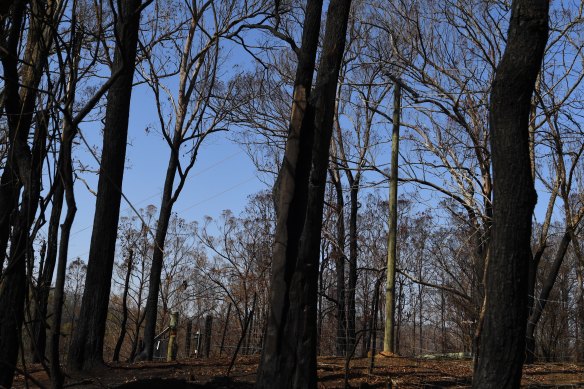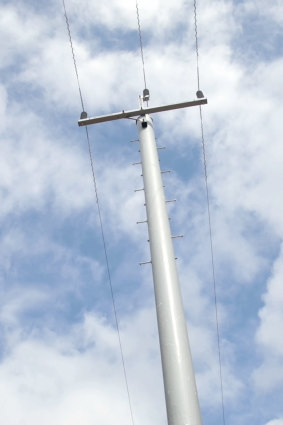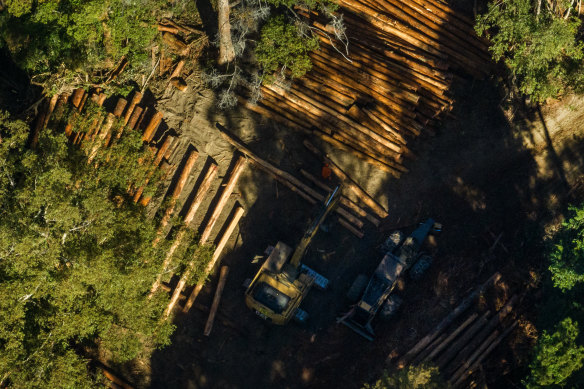Political fight sparks as electricity network axes timber power poles
The electricity network that covers 95 per cent of NSW is phasing out wooden power poles, sparking a fight with the timber industry and the Coalition, but delighting environmentalists campaigning to end native forest logging.
The timber poles come almost exclusively from state forests on the Mid North Coast, many of which are likely to become part of the Great Koala National Park promised by the Minns government before the election. It comes as an analysis of publicly available data shows a high level of logging within the boundaries proposed by the National Parks Association of NSW.

A new timber electricity power pole stands in bushfire-ravaged land in Tinonee after the 2019 fires.Credit: Kate Geraghty
The Australian Forest Products Association (AFPA) says the Mid North Coast provides 90 per cent of power poles in NSW and 70 per cent nationwide.
Regional and rural electricity distributor Essential Energy is switching to power poles made from a fibreglass and resin composite with a UV coating to boost bushfire resilience.
A spokesperson said reducing the impact of natural disasters on customers was a key driver since burnt power poles can cause “loss of vital communications links, prolonged power outages and the cost of replacing power poles that are destroyed.”
The Essential Energy spokesperson said composite poles were made in regional NSW and Queensland and were fire-resistant, non-conductive in the case of lightning strike, immune to termites and resistant to decay. They are also lightweight, making them safer and faster to transport and install.
Essential Energy will proactively replace 2200 timber poles a year in bushfire-prone areas, and install a further 9000 composite poles a year as new installations or end-of-life replacements. The distributor said the cost to consumers would be less than $2 a year per household.
The Australian Energy Regulator approved Essential Energy’s switch at the end of April as part of its five-yearly review, which the electricity company said was in part because a shortage of timber poles is expected over the next five years. At least two other networks across Australia are also increasing usage of composite poles.

A composite power pole made of fibreglass and resin with UV coating.
The decision has infuriated the forestry industry, and the issue spilled over into the political arena this week when NSW Nationals leader Dugald Saunders called on NSW Energy Minister Penny Sharpe to reverse the decision since Essential Energy is a state-owned business.
In a statement, Saunders questioned the carbon emissions required to manufacture the composite poles. “Not only will this untested product be worse for the household budget by adding to power bills, but it will also be worse for the environment by increasing our carbon footprint,” he said.
Sharpe declined to comment.
James Jooste, NSW chief executive of the AFPA, said Essential Energy’s annual requirement for 10,000-12,000 hardwood poles was about a third of the state’s production of hardwood poles, which came exclusively from the Mid North Coast.
He said the shortfall in supply was due to political decisions to protect forests, including the creation of koala hubs while awaiting the declaration of the Great Koala National Park, and the Environment Protection Authority introducing new rules to protect gliders.
Forestry Corp directly employs 600 workers, but Jooste said the hardwood industry in NSW created 9000 jobs, mostly in regional areas. NSW Forestry Corporation still has four sites non-operational while it works through the new EPA rules.

Logs are sorted before being taken to a mill near Coffs Harbour.
Sharpe is still consulting on the exact boundaries of the Great Koala National Park, which the National Parks Association of NSW has proposed would span 315,000 hectares of public land in the Coffs Harbour region. Last year Sharpe suspended logging in 106 identified koala “hubs”, but logging is continuing apace in adjacent forests slated for protection.
The NSW Forestry Corporation has 11 active logging areas inside the boundaries proposed by the National Parks Association out of 24 on the North Coast. Nearly 20 per cent of North Coast state forests are inside the proposed national park footprint, but these forests account for 45 per cent of logging in the region by area. However, area is only one measure of logging activity, and may not directly translate to yield.
Justin Field from the Forest Alliance NSW said timber power poles were not only more susceptible to fire, but logging also made the forests more prone to high-intensity fires.
“The only explanation for the timber industry and NSW Nationals to oppose this move is that they are trying to protect logging profits at the expense of community safety and resilience,” Field said.
He added that most trees taken from native forests end up as cardboard or exported as wood chips.
Victoria ended native logging in state forests at the beginning of this year, while state-owned native timber in south-east Queensland is due to end in December.
Get to the heart of what’s happening with climate change and the environment. Sign up for our fortnightly Environment newsletter.